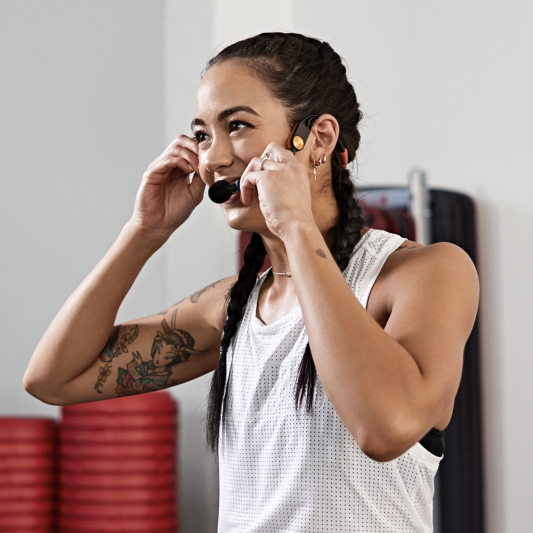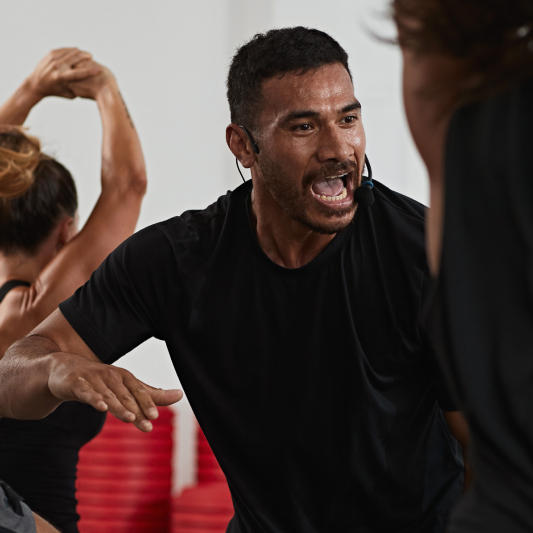Do you remember the release you first trained on at Initial Training? And how long it took you to learn it? If you were to describe how you felt back then, would “overwhelmed” be appropriate?!
One of the many benefits of teaching for years is that you discover little tips and tricks to get that release into your brain faster. While we wish we could learn the latest choreography by osmosis, the reality is that we do need to devote a certain amount of time every quarter to mastering the new material. Whether you’re brand new to teaching or a studio veteran, here are 8 ideas to speed up your learning:
- LISTEN TO THE MUSIC WHENEVER YOU CAN
“I always start with the music,” says Matt Thraxton (China). “I try to listen to the release as often as possible: in the shower, in the car, on the train, working out, making dinner, doing laundry. Certain lyrics, rhythms, patterns, instruments and musical landmarks will start to pop out for me. I know that the better I know the music, the more natural and relaxed I will feel when I teach. I usually listen to the release a few times in sequence to get a feel for the flow of that particular workout, and then I’ll have a playlist of each new release on shuffle to test my learning of the individual tracks.”
- PHYSICALLY DO THE WORKOUT
It helps to experience the workout before you teach it so you can: (a) create muscle memory for the movements; (b) understand where the moments of intensity lie – this will help your coaching; (c) practice any new moves before you demonstrate them in class.
Doing the workout with a participant mindset will help you coach your class to get the most out of the workout. For example, if the Squat Track in BODYPUMP™ has calf raises to a faster tempo, experiencing this yourself will help you advise members on weight selection. Or if there’s a rep challenge in LES MILLS GRIT™, trying it yourself means you can suggest different ways to break the blocks up for your class (if there are 50 reps – would you suggest they do them unbroken or break them up into manageable chunks?)

- IDENTIFY PATTERNS
“Look at the notes and you'll see some sets are repeated over and over again.” says Dee Lucas (US). “You'll see/hear the chorus and the exact same sequence is repeated every time in the chorus. When you see those patterns, you'll know you're really only having to learn choreography for half the track because the rest is just repeating the same sets, or almost identical sets with very tiny changes.”
Nadia Hassan (US) agrees: “I am a very visual learner so when I get a new release, I print out the choreography notes and highlight every block of work that is similar. In BODYCOMBAT, it's the A, B, C, etc. In BODYPUMP, I highlight the blocks of work 1, 2, 3, that are similar in the same colors. This way, when I'm teaching, I can visually see the colors. I know that in the Back Track there are two green sets before two blue sets.”
- TURN THE PRESENTER VOICES OFF
“I have a ‘pressure practice’ idea,” says Justin Riley (UK). “This is where I play the Masterclass footage with Presenter voice off and pretend to teach the track to members. I’ll move with the music and coach out loud whilst also dealing with external distractions like the dog, the TV in the background, or even answering a question from someone in the house. This helps me to determine how well I truly know the track. If I stay on track with all this happening at once then I’ve got it! If I lose my way, I’ll check the Masterclass footage and get back on track. I’ll then re-do the same practice of that track and correct the part that threw me. This is to add an extra level of realism to practising at home.
In a live class situation, there are always distractions or moments of impromptu connection that will take your attention from purely teaching the choreography. It’s very easy to focus on just the music and moves, which can give you a false sense of security that you’ve truly learnt it well enough to teach and deal with distractions.”
- WRITE THE CHOREOGRAPHY DOWN IN AN ABBREVIATED FORM/ YOUR OWN WAY
“For years, I solely watched the Masterclass to learn a release,” says Sarah Chermely (US). “It would take weeks because I’d get distracted by the clothes, lights or cues from the Presenters. One day, I tried something different and it’s been a major time saver! First, I listen to the music as much as I can (while cleaning, driving, lifting weights), then watch the Masterclass while writing down the choreography. The simple act of writing the choreography down cements it in my brain. Since I have usually listened to the music beforehand, I know the highs and lows, which brings the whole release together much quicker! Now, I can learn BODYPUMP in 2 to 3 hours total, LES MILLS SPRINT™ in 30 min and BODYSTEP™ will take about 4 to 6 hours."

- DO A ‘PRACTICE LAUNCH’ WITH OTHER INSTRUCTORS
If you can, have a rehearsal class with other Instructors at your club. Remember, the Masterclass presenters have multiple rehearsal classes before they film the release – they never come to it cold. The more you practice before launch, the more confident you’ll feel when you step on stage at launch.
“Practice in front of the mirror,” suggests Ramsey Clark Amaba (Middle East). “It’s even better if you have someone else you can practice with! It makes it more fun and can help identify the performance moments of the track.”
Fellow Middle East Instructor, Ibaa Al Masri, adds: “Just remember, if you still go off the beat while practicing, or you forget what the next move is, this is likely to happen on the stage, so an error-free practice class is an error-free live class.”
- TEAM-TEACH THE NEW RELEASE
We love team-teaching for many reasons – more energy, interaction with your co-teachers, more fun for the members – but also because it means we don’t have to learn everything at once!
Putting up your hand for launch classes (or recruiting other Instructors to help in your class) benefits everyone. Particularly if you teach multiple programs, getting involved in team-teaches can help take the pressure off AND give you some cool coaching ideas from your colleagues.
- IT DOES GET EASIER!
If you are just starting out, the idea of learning a release in a couple of hours may seem impossible. Give yourself time and identify what works best for you. Do you need to learn tracks one at a time, or do you prefer to tackle the whole release at once? If you teach multiple programs, do you learn them simultaneously, or would you prefer to nail each one separately?
Also – don’t be too hard on yourself. We’re all human and your participants will forgive choreography errors. Plus, when it’s the new release, they probably won’t even notice. As Sean Rafael (UK) suggests, if you do completely stuff up the choreography and have no idea what comes next: "Shouting ‘Remix!’ is a great way of acknowledging you goofed something without apologizing and feeling bad."







